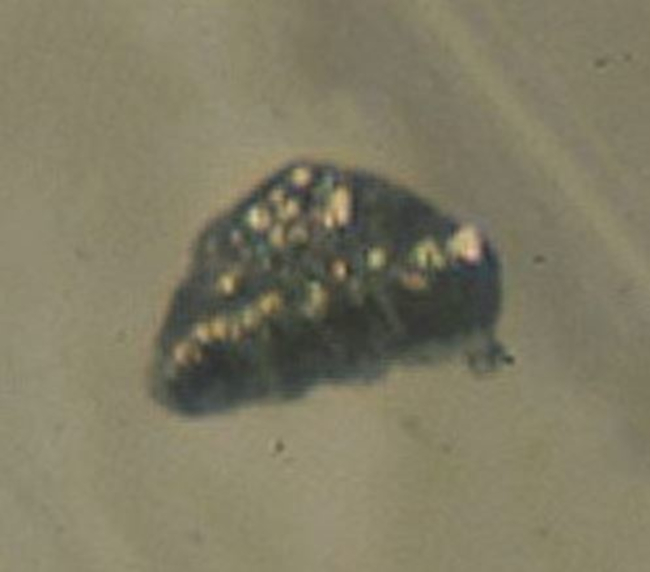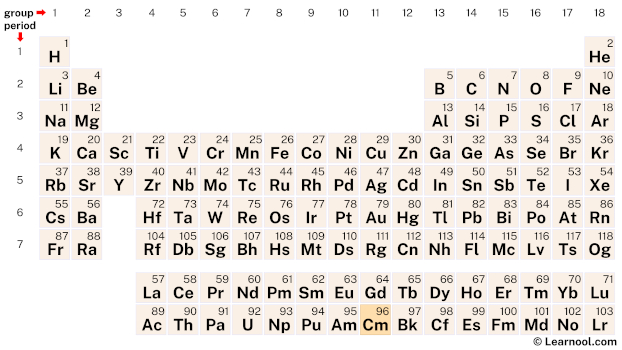
Curium (Cm) is a chemical element of the periodic table, located in the period 7, and has the atomic number 96. It is the eighth element in the actinide series. It is a hard, silvery-white metal which is named in honour of Marie and Pierre Curie. It is the fourth transuranium element and is counted as one of the radioactive elements.
On periodic table
| group | ⇨ | 1 | 2 | 3 | 4 | 5 | 6 | 7 | 8 | 9 | 10 | 11 | 12 | 13 | 14 | 15 | 16 | 17 | 18 |
| period | ⇩ | ||||||||||||||||||
| 1 | 1 H  Hydrogen |
2 He  Helium |
|||||||||||||||||
| 2 | 3 Li  Lithium |
4 Be  Beryllium |
5 B  Boron |
6 C  Carbon |
7 N  Nitrogen |
8 O  Oxygen |
9 F  Fluorine |
10 Ne  Neon |
|||||||||||
| 3 | 11 Na  Sodium |
12 Mg  Magnesium |
13 Al  Aluminium |
14 Si Silicon |
15 P  Phosphorus |
16 S  Sulfur |
17 Cl  Chlorine |
18 Ar  Argon |
|||||||||||
| 4 | 19 K  Potassium |
20 Ca  Calcium |
21 Sc  Scandium |
22 Ti  Titanium |
23 V  Vanadium |
24 Cr  Chromium |
25 Mn  Manganese |
26 Fe  Iron |
27 Co  Cobalt |
28 Ni  Nickel |
29 Cu  Copper |
30 Zn  Zinc |
31 Ga  Gallium |
32 Ge  Germanium |
33 As  Arsenic |
34 Se  Selenium |
35 Br  Bromine |
36 Kr  Krypton |
|
| 5 | 37 Rb  Rubidium |
38 Sr  Strontium |
39 Y  Yttrium |
40 Zr  Zirconium |
41 Nb  Niobium |
42 Mo  Molybdenum |
43 Tc  Technetium |
44 Ru  Ruthenium |
45 Rh  Rhodium |
46 Pd  Palladium |
47 Ag  Silver |
48 Cd  Cadmium |
49 In  Indium |
50 Sn  Tin |
51 Sb  Antimony |
52 Te  Tellurium |
53 I  Iodine |
54 Xe  Xenon |
|
| 6 | 55 Cs  Caesium |
56 Ba  Barium |
72 Hf  Hafnium |
73 Ta  Tantalum |
74 W  Tungsten |
75 Re  Rhenium |
76 Os  Osmium |
77 Ir  Iridium |
78 Pt  Platinum |
79 Au  Gold |
80 Hg  Mercury |
81 Tl  Thallium |
82 Pb  Lead |
83 Bi  Bismuth |
84 Po  Polonium |
85 At  Astatine |
86 Rn  Radon |
||
| 7 | 87 Fr  Francium |
88 Ra  Radium |
104 Rf  Rutherfordium |
105 Db  Dubnium |
106 Sg  Seaborgium |
107 Bh  Bohrium |
108 Hs  Hassium |
109 Mt  Meitnerium |
110 Ds  Darmstadtium |
111 Rg  Roentgenium |
112 Cn  Copernicium |
113 Nh  Nihonium |
114 Fl  Flerovium |
115 Mc  Moscovium |
116 Lv  Livermorium |
117 Ts  Tennessine |
118 Og  Oganesson |
||
| 57 La  Lanthanum |
58 Ce  Cerium |
59 Pr  Praseodymium |
60 Nd  Neodymium |
61 Pm  Promethium |
62 Sm  Samarium |
63 Eu  Europium |
64 Gd  Gadolinium |
65 Tb  Terbium |
66 Dy  Dysprosium |
67 Ho  Holmium |
68 Er  Erbium |
69 Tm  Thulium |
70 Yb  Ytterbium |
71 Lu  Lutetium |
|||||
| 89 Ac  Actinium |
90 Th  Thorium |
91 Pa  Protactinium |
92 U  Uranium |
93 Np  Neptunium |
94 Pu  Plutonium |
95 Am  Americium |
96 Cm Curium |
97 Bk  Berkelium |
98 Cf  Californium |
99 Es  Einsteinium |
100 Fm  Fermium |
101 Md  Mendelevium |
102 No  Nobelium |
103 Lr  Lawrencium |
|||||
| – f block |
Curium is a member of the actinide series, a group of elements located at the bottom of the periodic table. It can be found in period 7, between americium (Am) and berkelium (Bk).
Element information
 |
|
 |
|
| Origin of name | named in honour of Marie and Pierre Curie |
| Symbol | Cm |
| Atomic number (Z) | 96 |
| Atomic mass | (247) |
| Block | f-block |
| Period | 7 |
| Classification | Actinide |
| Atomic radius | 174 pm |
| Covalent radius | 169±3 pm |
| Melting point | 1340 ℃, 2444 ℉, 1613 K |
| Boiling point | 3110 ℃, 5630 ℉, 3383 K |
| Electron configuration | [Rn] 5f7 6d1 7s2 |
| Electrons per shell | 2, 8, 18, 32, 25, 9, 2 |
| Crystal structure | Double hexagonal close-packed (dhcp) |
| Phase at r.t | Solid |
| Density near r.t | 13.51 g/cm3 |
| Natural occurrence | Synthetic |
| Oxidation state | +3 |
| Electronegativity (Pauling scale) | 1.3 |
| Protons Neutrons Electrons |
96 151 96 |
| CAS number | 7440-51-9 |
| Discovered by | Glenn T. Seaborg, Ralph A. James, and Albert Ghiorso in 1944 |
History
Curium was first synthesized in 1944 by a team of American scientists at the University of California, Berkeley. The team was led by Glenn T. Seaborg, who had previously discovered several other transuranic elements including plutonium, americium, and berkelium.
The discovery of curium was a result of a series of experiments involving the bombardment of plutonium-239 with alpha particles. Seaborg and his team were able to isolate curium from a sample of this mixture, and named it after Marie and Pierre Curie, the famous scientists who discovered radioactivity.
The discovery of curium was a significant achievement in the field of nuclear chemistry, as it provided scientists with a better understanding of the behavior of heavy elements and their isotopes. It also opened up new avenues of research into the properties and potential applications of synthetic elements.
Occurrence and production
Curium is a synthetic element and does not occur naturally on Earth. It is produced by the irradiation of plutonium or other heavy elements in a nuclear reactor.
Curium is produced by the neutron irradiation of plutonium or other heavy elements in a nuclear reactor. The resulting radioactive isotopes undergo a series of decay reactions, ultimately producing curium. The production of curium is usually carried out in small quantities in specialized nuclear research laboratories. It is also produced in larger quantities as a by-product of the production of plutonium in nuclear reactors.
Properties
Curium is a silvery-white, radioactive metal. Its melting point is 1340 ℃ and its boiling point is estimated to be around 3110 ℃.
Curium is a member of the actinide series, a group of elements that are all radioactive and have properties similar to those of the element actinium.
It is a synthetic element, meaning it is not found naturally on Earth and must be produced in a laboratory.
Curium is highly radioactive and has a half-life of around 15.6 million years, meaning that it takes that long for half of a given sample of curium to decay into other elements.
Curium is a rare and expensive element, with estimated production costs of around $1000 per gram.
Due to its radioactivity and rarity, curium has no practical applications and is primarily used for research purposes.
Applications
Nuclear research
Curium is widely used in nuclear research as a neutron source. It can be used in neutron radiography to detect defects in metal castings and welding seams. It is also used to start and control nuclear reactions in experimental reactors.
Medical research
Curium isotopes are used in medical research to label proteins and DNA for biological research.
Radiation sources
Curium-244 is used as a gamma ray source in portable X-ray fluorescence spectrometry. It is also used as a calibration source for radiation detectors.
Space exploration
Curium has been used in space exploration. The Mars Science Laboratory, for example, used curium-244 in its power system.
Material science
Curium is used in the study of materials science. Its properties, particularly its high melting point and thermal conductivity, make it useful in the study of materials at high temperatures.
Interesting facts
Curium was named after Marie Curie and her husband Pierre Curie, who were pioneers in the study of radioactivity.
It is a radioactive metal and has no known biological role.
Curium was first produced in 1944 by bombarding plutonium-239 with alpha particles in a cyclotron.
Curium is the heaviest element that can be obtained in macroscopic quantities and can be produced in nuclear reactors.
It is used in the production of heavier actinides such as berkelium and californium.
Curium isotopes can be used as a fuel in radioisotope thermoelectric generators (RTGs) to power spacecraft and other remote facilities.
Curium-242 is used in the oil industry as a neutron source for well-logging, which helps to determine the properties of underground formations.
Curium-244 is used in the detection of explosives and as a radiation source for cancer therapy.
Curium has a bright, silvery appearance and is chemically reactive, similar to other actinides.
Curium has 19 known isotopes, and the most stable one is curium-247, which has a half-life of 15.6 million years.
Related
More elements
External links
- https://www.rsc.org/periodic-table/element/96/curium
- https://en.wikipedia.org/wiki/Curium
- https://www.britannica.com/science/curium-chemical-element
- https://pubchem.ncbi.nlm.nih.gov/element/Curium
- https://www.livescience.com/39915-facts-about-curium.html
- https://www.chemicool.com/elements/curium.html
- https://study.com/academy/lesson/what-is-curium-used-for.html
Deep
Learnool.com was founded by Deep Rana, who is a mechanical engineer by profession and a blogger by passion. He has a good conceptual knowledge on different educational topics and he provides the same on this website. He loves to learn something new everyday and believes that the best utilization of free time is developing a new skill.
